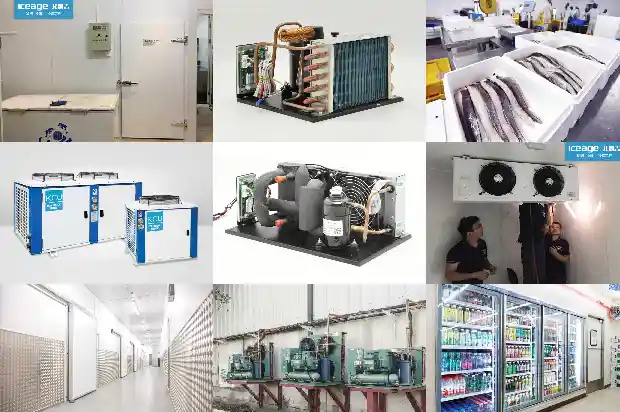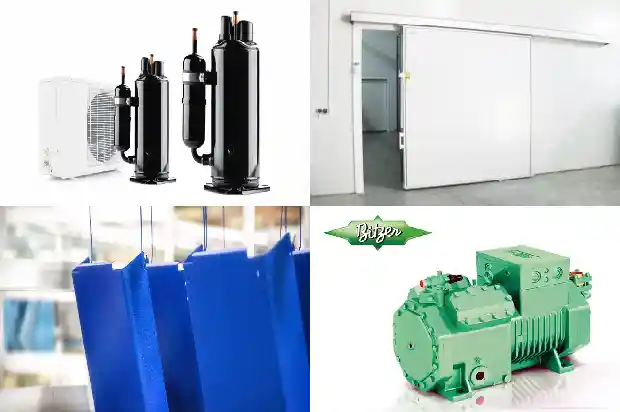Common Causes of Frost Build-up in refrigerant evaporators
2024-09-07
As an important component of the refrigeration system of cold storage, when the air cooler works at a temperature lower than 0°C and lower than the dew point of the air, frosting begins on the surface of the evaporator. As the operating time increases, the frost layer will become thicker and thicker. A thicker frost layer will lead to two main problems: one is the increase of heat transfer resistance. The cooling capacity in the evaporator coil cannot be effectively transferred to the cold storage through the tube wall and frost layer; Another problem: The thicker frost layer forms a greater wind resistance for the fan motor, resulting in a reduction in the air volume of the air cooler and also reducing the heat transfer efficiency of the air cooler.
Some simple analyses have been made on the reasons for frosting of air coolers (evaporators):
- Insufficient air supply, including blockage of air supply and return ducts, blockage of filters, blockage of fin gaps, fan not rotating or reduced speed, etc., resulting in insufficient heat transfer, reduced evaporation pressure, and reduced evaporation temperature;
- Problems with the heat exchanger itself.
With common use of the heat exchanger, the heat transfer performance declines, reducing the evaporation pressure;
- The external temperature is too low. Generally, for civil refrigeration, it will not be lower than 20°C. Refrigeration in a low-temperature environment will cause insufficient heat transfer and low evaporation pressure;
- The expansion valve is blocked or the pulse motor system that controls the opening degree is damaged.
In a long-term operating system, some debris will block the expansion valve port and make it unable to work normally, reducing the refrigerant flow rate and reducing the evaporation pressure. Abnormal opening control will also cause a reduction in flow and pressure;
- Secondary throttling. There are pipe bends or debris blockages inside the evaporator, resulting in secondary throttling, which reduces the pressure and temperature of the part after secondary throttling;
- Poor system matching.
To be precise, the evaporator is relatively small or the compressor operating condition is too high. In this case, even if the evaporator performance is fully exerted, due to the excessive compressor operating condition, the suction pressure will be low and the evaporation temperature will drop;
- Lack of refrigerant, low evaporation pressure, and low evaporation temperature;
- Relatively high relative humidity in the cold storage, or incorrect installation position of the evaporator or frequent opening and closing of the cold storage door;
- Incomplete defrosting. Due to insufficient defrosting time and unreasonable position of the defrost reset probe, the evaporator starts to operate when the defrosting is incomplete. After multiple cycles, the local frost layer of the evaporator turns into ice and accumulates and grows.
Why does the evaporator in the cold storage frost? Due to the frosting on the surface of the evaporator in the cold storage, it hinders the conduction and dissipation of cooling capacity of the refrigeration evaporator (pipeline) and affects the refrigeration effect. When the thickness of the frost layer (ice layer) on the surface of the evaporator reaches a certain extent, the refrigeration efficiency may even drop below 30%, resulting in a large waste of electrical energy and shortening the service life of the refrigeration system. Therefore, it is necessary to perform defrosting operations on the cold storage in an appropriate cycle.
Methods of defrosting cold storage: hot gas defrosting (hot fluorine defrosting, hot ammonia defrosting), water spraying defrosting, electrical defrosting, mechanical (manual) defrosting, etc.
- Hot gas defrosting - suitable for defrosting of large, medium and small cold storage pipe arrangements: directly introduce the hot high-temperature gaseous condensate into the evaporator without throttling. The temperature of the evaporator rises, promoting the melting or subsequent peeling off of the junction between the frost layer and the pipe row. Hot gas defrosting is economical, reliable, convenient for maintenance and management, and its investment and construction difficulty are not great.
- Water spraying defrosting - mostly used for defrosting large and medium-sized air coolers: regularly spray the cooling evaporator with normal temperature water to melt the frost layer. Although water spraying defrosting has a very good defrosting effect, it is more suitable for air coolers. For evaporator coils, it is difficult to operate. A solution with a relatively high freezing point temperature, such as 5% to 8% concentrated brine, can also be sprayed on the evaporator to prevent frost formation.
- Electric heating defrosting - electric heating tubes are mostly used in medium and small air coolers: electric heating wires are mostly used for electric heating defrosting of medium and small cold storage aluminum pipe rows. For air coolers, it is simple and easy to implement and convenient to use; but for the case of cold storage with aluminum pipe rows, the construction difficulty of installing electric heating wires on aluminum fins is not small, and the failure rate in the future will also be relatively high. The maintenance and management is difficult, the economy is poor, and the safety factor is relatively low.
- Mechanical manual defrosting - suitable for defrosting small cold storage pipe arrangements: Manual defrosting of cold storage pipe arrangements is relatively economical and is the original defrosting method. Manual defrosting of large cold storages is not practical. Looking up for operation is difficult, physical energy consumption is too fast, staying in the warehouse for too long is harmful to health, defrosting is not easy to be thorough, and it may cause deformation of the evaporator and even damage the evaporator guide, resulting in refrigerant leakage accidents.

Purposes of defrosting cold storage:
- Improve the refrigeration efficiency of the system;
- Ensure the quality of frozen products in the warehouse;
- Save electrical energy;
- Prolong the service life of the cold storage system.
Related Articles
- What Are the Common Causes of Cold Air Blower Noise?
- Air - conditioner Low - pressure Alarm? These Nine Common Causes
- What Are the Causes of Scroll Compressor Damage?
- Causes and Prevention of "Primary Condensation" and "Secondary Condensation" in Fan - Coil Units
- 10 Symptoms and Causes of Abnormal Frosting in Heat Pumps
- Common Causes and Analysis of High and Low Pressure Alarms
- Common Causes and Analysis of Compressor Thermal Protection
- 4 Points on Causes of Water Leakage in Closed Cooling Towers
- Analysis of Causes for Safety Valve Leakage
- What Causes Noise in Pressure Reducing Valves?
- Causes and Solutions for Elevated Pressure in Cold Storage
- What Causes Poor Refrigeration Effect of Refrigerated Trucks?
- Common Causes of Air Conditioner Compressor Failures
- Influence of Fin Spacing of Evaporator in Air Cooler on Frost Formation
- Reasons for Frost Formation in Cold Storage and Defrosting Methods
- Frosting and Defrosting Issues of Air - cooled Heat Pumps
- Fin Spacing Design of Cooler and Several Knowledge Points of Defrosting in Cold Storage
- Defrosting Operation Modes of Refrigeration Equipment and Its Control Components
